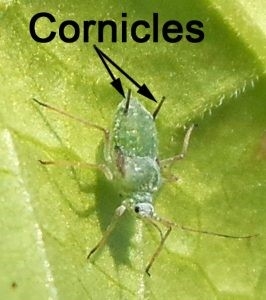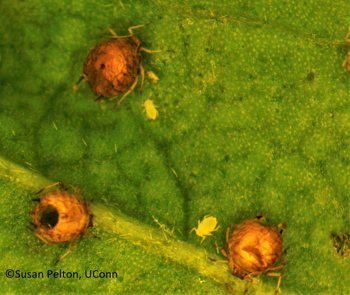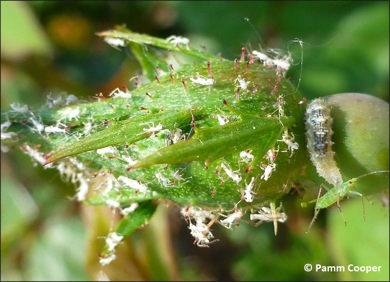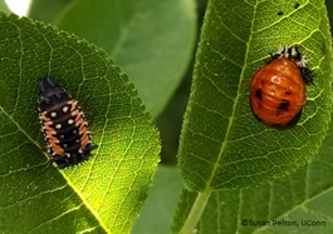Aphids can be serious and persistent pests in the home and garden landscape. They feed on wide range of plants, including fruits, vegetables and ornamentals. They are difficult to control due to their high reproductive capability and resistance to many different insecticides. Aphids are sucking insects that can cause curling and distortion of tender young growth. The presence of aphids, their white shed exoskeletons, and honeydew can reduce the aesthetic quality of a wide range of crops and ornamental plants. Damage from heavy feeding can cause loss of plant vigor.
Aphids are small (less than 1/8” long), soft-bodied, pear-shaped insects with long legs and antennae. The color can vary from white, yellow, green, red, brown and black. Aphids are the only insect to have cornicles, which resemble two tailpipes on the rear of the abdomen. They have piercing/sucking mouthparts and feed exclusively on plant sap. Aphids may feed on stems, leaves, flower buds and even roots, depending on species. They reproduce rapidly to form colonies particularly on new growth.

World-wide there are about 5,000 species of aphids with nearly 1,500 found throughout North America. Their distribution is dependent on the plant hosts the particular species prefers. Some of the most common species include the green peach aphid (Myzus persicae), melon or cotton aphid (Aphis gossypii), foxglove aphid (Aulacorthum solani) and the honeysuckle aphid (Hyadaphis tataricae). Additional important aphid species include potato aphids (Macrosiphum euphorbiae), which may occasionally occur along with the cabbage aphids (Brevicoryne brassicae), and chrysanthemum aphids (Macrosiphoniella sanborni). Tulip bulb aphids (Dysaphis tulipae) can infect many different bulbs in storage. The milkweed aphid (Aphis nerii), is a bright yellow aphid that can form large colonies on milkweed stems and leaves and may cause flowers and pods to abort and even kill plants.
Life Cycle
Aphids under go incomplete metamorphosis and often have complicated life cycles. Aphids overwinter as eggs laid near leaf buds or in bark crevices. Eggs hatch as nymphs as new foliage appears next spring. This generation consists of wingless females. These nymphs will molt several times leaving behind their whitish, cast-off exoskeletons. As adults these females can reproduce without mating, through a process called parthenogenesis. Each female can give birth to 60 to 100 live nymphs. A winged generation will be produced that will fly to an alternate host plant. The last generation of the year will consist of both winged male and female adults that will mate. Fertilized females will lay eggs on an alternate host plant where eggs will overwinter. Aphids may or may not have wings depending on species or which generation is observed.
Feeding Damage
Aphids feed by inserting their needle-like stylet mouth part into the phloem of the host plant and removing plant sap. Aphids may feed singly but are most often found feeding in dense groups on newer leaves, stems and flower buds. These colonies don’t move rapidly when disturbed. Feeding injury, including plant wilting, stunting, leaf curling and twisting of young leaves, may result if aphid populations are high. Portions of the plant above stem feeding may wilt if populations are high. As aphids feed, a sugar-rich liquid known as honeydew is excreted. The presence of honeydew provides a nutrient source for black sooty mold to develop, which can subsequently reduce host plant photosynthesis. Sooty mold can be washed off with water or can be brushed off by hand.

Control
Cultural
Aphids may cause unsightly damage to a plant but they rarely kill a mature plant. Look under leaves where they may hide. Prune off severely damaged plant material. Reduce nitrogen fertilizer application, as excessive nitrogen promotes lush growth that is favorable to aphid development. Aphid-infested weeds are frequently a source of recurring aphid problems. Inspect and remove infested weeds promptly. A strong spray of water may dislodge feeding aphids and they rarely find their way back to the affected plant. Spraying should occur early in the day to allow the plant to dry off to avoid fungal issues.
Biological
There are various species of parasitic wasps that lay their eggs inside aphids. The egg hatches while still inside the aphid and the young larva
grows, feeding off of the aphid’s insides. Once feeding is complete, the aphid’s body mummifies, becoming a round, brown shell. The wasp larva then attaches the mummified host to the leaf with a silken thread, spins a cocoon, and pupates inside. The adult wasp then emerges by chewing a hole through the mummified host, as seen in the image below.

Lady beetle and lace wing adults and larvae are voracious natural predators of aphids and other soft bodied insects. Other beneficial predators of aphids include soldier beetles and syrphid fly larvae. If these predatory insects are already present on an aphid-infested plant, then other control measures may not be necessary.


Chemical
If the population of aphids is very high insecticidal soaps, horticultural oil and Neem oil may be used. These products need to be sprayed directly on the aphids and will only affect the aphids that are present at the time of spraying so multiple applications may be required. These chemicals may also kill some of the aphid’s natural enemies that are present on the plant and hit by the spray, but they leave no toxic residue that will kill natural enemies that migrate in after the spraying. Contact insecticides may not reach aphids that resided inside curled leaves. Chemical formulations that combine insecticidal soaps with pyrethrins may have a stronger effect and will break down quickly, leaving little residue to affect beneficial insects that may appear later. Before using systemic insecticides ensure they are labeled for aphid control and will not harm bees.
Despite good cultural practices, pests and diseases at times may appear. Chemical control should be used only after all other methods have failed. For pesticide information or other questions please call toll free: 877-486-6271.
UConn Home and Garden Education Center, 2020